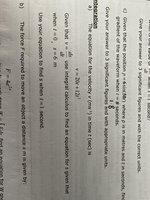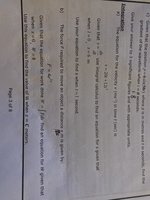You are using an out of date browser. It may not display this or other websites correctly.
You should upgrade or use an alternative browser.
You should upgrade or use an alternative browser.
Struggling with integration
- Thread starter Joewr13
- Start date
Dr.Peterson
Elite Member
- Joined
- Nov 12, 2017
- Messages
- 16,092
The equation says that ds/dt = 20t + 12t^2.Hi I’m stuck on a integration question as I’m not sure how to find v=ds/dt when the S variable isn’t in the original equation I’ve attached a photo it is question a), thanks
Integrate, as they say. The goal is to find s, not v.
thanks I don’t know how I didn’t see that all I needed was to see the equation wrote in the ds/dt form and i found it pretty easy thanks to you!The equation says that ds/dt = 20t + 12t^2.
Integrate, as they say. The goal is to find s, not v.
I’ve always struggled with integration would u mind taking a look at question B has well I don’t know where to start, would be much appreciated thanksthanks I don’t know how I didn’t see that all I needed was to see the equation wrote in the ds/dt form and i found it pretty easy thanks to you!
Attachments
Dr.Peterson
Elite Member
- Joined
- Nov 12, 2017
- Messages
- 16,092
Again they want you to do nothing but the obvious; but they messed up the wording (as far as the physics is concerned). I don't think it makes any sense at all!I’ve always struggled with integration would u mind taking a look at question B has well I don’t know where to start, would be much appreciated thanks
Rather than "the force F required to move an object a distance x meters", they surely mean something like "the force F applied to an object at coordinate x meters". And normally work is calculated as a definite integral, in my experience.
Ignore all that and just do as they say: Replace F with [MATH]4e^{2x}[/MATH] and integrate, choosing the appropriate constant. This is essentially the same as for part (a), just written in terms of an integral (W = ∫F dx) rather than a derivative (dW/dx = F).
This helps so much however when calculating a definite integral don’t you need boundary conditions so in this case it would be the distance the object traveled but the question doesn’t state how far the object moved?Again they want you to do nothing but the obvious; but they messed up the wording (as far as the physics is concerned). I don't think it makes any sense at all!
Rather than "the force F required to move an object a distance x meters", they surely mean something like "the force F applied to an object at coordinate x meters". And normally work is calculated as a definite integral, in my experience.
Ignore all that and just do as they say: Replace F with [MATH]4e^{2x}[/MATH] and integrate, choosing the appropriate constant. This is essentially the same as for part (a), just written in terms of an integral (W = ∫F dx) rather than a derivative (dW/dx = F).
Dr.Peterson
Elite Member
- Joined
- Nov 12, 2017
- Messages
- 16,092
Ohhh that is so much easier to understand thanks a lot!As I said, ignore what they say about the supposed application, and just do what they say, taking an indefinite integral and finding the appropriate constant, as you did in the other part.
That is, pretend all they gave you was this:
View attachment 27791


